Multiple Choice
Identify the
choice that best completes the statement or answers the question.
|
|
|
1.
|
Which of these numbers is not a perfect square: 121, 2, 100, or 4?
|
|
|
2.
|
Which 2 consecutive square numbers is 54 between?
a. | 53 and 55 | b. | 28 and 32 | c. | 49 and 64 | d. | 12 and 16
|
|
|
|
3.
|
Find the number whose square root is 36.
|
|
|
4.
|
Which whole number is  closer to?
|
|
|
5.
|
Simplify  to the nearest whole number.
|
|
|
6.
|
Estimate  to 1 decimal place.
|
|
|
7.
|
Find the area of the indicated square. 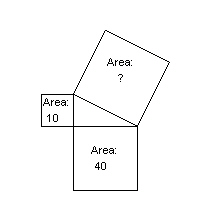 a. | 50 square units | c. | 400 square units | b. | 30 square units | d. | 7.1 square
units |
|
|
|
8.
|
Find the length of the hypotenuse. Give your answer to 1 decimal place. 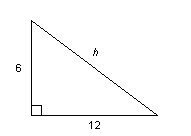 a. | 144.0 | b. | 10.4 | c. | 13.4 | d. | 36.0 |
|
|
|
9.
|
Find the length of the diagonal, d, in the rectangle. Give your answer to
the nearest centimetre. 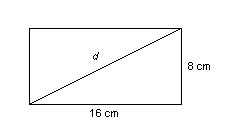 a. | 320 cm | b. | 18 cm | c. | 24 cm | d. | 14
cm |
|
|
|
10.
|
Find the length of the diagonal, d, in the square. Give your answer to 1
decimal place. 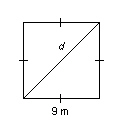 a. | 9 m | b. | 162 m | c. | 18 m | d. | 12.7 m |
|
|
|
11.
|
The area, in square centimetres, of the square on each side of a triangle is
given. Which triangle is a right triangle? 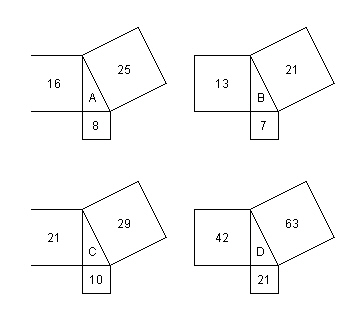 a. | Triangle A | b. | Triangle B | c. | Triangle C | d. | Triangle
D |
|
|
|
12.
|
The areas, in square centimetres, of the largest square and one of the smaller
squares on the sides of a right triangle are given. Determine the area of the third square.  a. | 74 cm2 | b. | 2 cm2 | c. | 24 cm2
| d. | 5
cm2 |
|
|
|
13.
|
The legs of a right triangle measure 11 cm and 8 cm. What is the length of the
hypotenuse?
a. | 185 cm | b. |  cm cm | c. | 19 cm | d. | 361
cm |
|
|
|
14.
|
Find the length of the hypotenuse. Give your answer to 1 decimal
place. 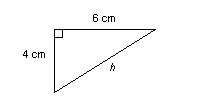 a. | 4.7 cm | b. | 7.2 cm | c. | 4.5 cm | d. | 6.3
cm |
|
|
|
15.
|
How many triangular faces are there in a hexagonal prism?
|
|
|
16.
|
Calculate the area of this net of a right triangular prism. 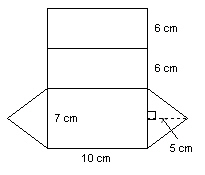 a. | 225 cm2 | b. | 207.5 cm2 | c. | 165 cm2 | d. | 147.5
cm2 |
|
|
|
17.
|
The base of a right triangular prism has an area of 9 cm2 and a
perimeter of 11 cm.
If the height of the prism is 10 cm, find the total surface area of the
prism.
a. | 30 cm2 | b. | 119 cm2 | c. | 99 cm2 | d. | 128
cm2 |
|
|
|
18.
|
A full tray of fudge is shared equally among 24 students.
The tray measures
12 cm by 9 cm and is 2 cm deep.
How much fudge, to the nearest tenth of a cubic centimetre, does
each student get?
a. | 11 cm3 | b. | 4.5 cm3 | c. | 3.8 cm3 | d. | 9
cm3 |
|
|
|
19.
|
Find the volume of this triangular prism. 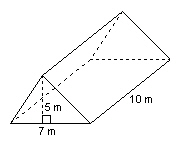
|
|
|
20.
|
Find the volume of this triangular prism.  a. | 12 m3 | b. | 3 m3 | c. | 24 m3 | d. | 4
m3 |
|
|
|
21.
|
The area of the base of a right triangular prism is 14.5 cm2 and the
length of the prism is 6 cm.
Calculate the volume of the prism.
a. | 87 cm3 | b. | 43.5 cm3 | c. | 174 cm3 | d. | 20.5
cm3 |
|
|
|
22.
|
Find the surface area of this cylinder to the nearest square metre.  a. | 905 m2 | b. | 704 m2 | c. | 653 m2 | d. | 452
m2 |
|
|
|
23.
|
A paper cup has the shape of a perfect cylinder that is 6.9 cm tall and 3 cm
across. Find the area of paper needed to make the cup. Use  and give the answer to the
nearest square centimetre. a. | 65 cm2 | b. | 72 cm2 | c. | 79 cm2 | d. | 53
cm2 |
|
|
|
24.
|
Find the volume of this cylinder. Round your answer to the nearest
tenth. 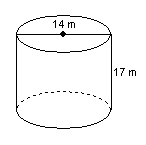 a. | 747.7 m3 | b. | 373.8 m3 | c. | 2616.9 m3 | d. | 238
m3 |
|
|
|
25.
|
Find the volume of this cylinder. Round your answer to the nearest cubic
unit. 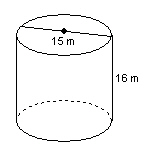 a. | 2827 m3 | b. | 754 m3 | c. | 1414 m3 | d. | 931
m3 |
|
|
|
26.
|
The height of a cylindrical oil storage tank is 6 m and it has diameter 22 m.
If the tank is full, how much oil does it contain? Round your answer to the nearest kL. (1 kL = 1
m3)
a. | 207 kL | b. | 415 kL | c. | 2281 kL | d. | 908
kL |
|
|
|
27.
|
This object is made using 4 linking cubes. Draw the top view of the
object. 
|
|
|
28.
|
This object is made using 4 linking cubes. Draw the right side view of the
object. 
|
|
|
29.
|
An object is made using 3 linking cubes. The diagram shows 2 views of the
object. Draw the top view of the object.  
|
|
|
30.
|
This object is made using linking cubes. Draw the top view of this
object. 
|
Short Answer
|
|
|
31.
|
Which of these numbers is a perfect square: 34, 36, 38, or
40?
|
|
|
32.
|
Find 82.
|
|
|
33.
|
Find 92 + 52.
|
|
|
34.
|
What is a factor?
|
|
|
35.
|
Copy each square on grid paper. Which square has the greater area? 
|
|
|
36.
|
Copy the line segment on grid paper. Draw a square on the line
segment. Find the area of the square and the length of the line segment. 
|
|
|
37.
|
Write N. Estimate the value of N to 1 decimal place. 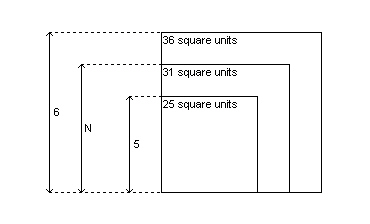
|
|
|
38.
|
Is this set of numbers a Pythagorean triple? How do you know?
2, 21,
29
|
|
|
39.
|
Determine whether a triangle with each set of side lengths is a right triangle.
a) 9 cm, 12, cm, 15
cm
b) 24 cm, 10 cm, 26 cm
c) 22 cm,
21, cm, 30 cm
d) 21 cm, 20 cm, 29 cm
|
|
|
40.
|
ABCD is a parallelogram with  . Find the length of BD. Give the
length to the nearest millimetre. 
|
|
|
41.
|
The net for a cereal box is shown. Describe the shape and dimensions of the
box. 
|
|
|
42.
|
Find the surface area of this right rectangular prism. 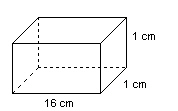
|
|
|
43.
|
A jewelry store uses small boxes to store items they sell. This diagram shows
one of the boxes. Find the surface area of the box. 
|
|
|
44.
|
Find the surface area of this right rectangular prism. 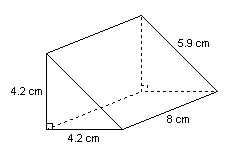
|
|
|
45.
|
Find the area of this net. Give your answer to the nearest square
centimetre. 
|
|
|
46.
|
This object is made using linking cubes. Sketch the right side, front, and top
views of the object. 
|
|
|
47.
|
Sketch the front, top, and right side views of this object.  RightFront RightFront
|
|
|
48.
|
|
|
|
49.
|
An object has the same top, front, and side views. Describe a possible
object.
|
|
|
50.
|
These are the front, side, and top views of an object. Sketch a 3-D picture
of the object. Label the dimensions. 
|
Problem
|
|
|
51.
|
The numbers 2, 3, 5, 7, 11, and 13 are written on separate cards.
Which
pairs of numbers give a sum that is a perfect square?
Find all possible solutions.
|
|
|
52.
|
Use 1-cm grid paper. Draw as many different rectangles as you can with area
36 cm 2. Find the base and height of each rectangle. Record the results in a
table. Base
(cm) | Height
(cm) | Perimeter
(cm) | | | | | | | | | | | | | | | | | | | | | | | | | | | | | | | | | | | | | | | |
Which rectangle has the least
perimeter? What can you say about this rectangle?
|
|
|
53.
|
Use a table like this. Number = 144 | Factor Pairs | 1 | 144 | 2 | | | | | | |
List the factor pairs of these numbers: 4, 9, 25, and 49. What
can you say about these numbers?
|
|
|
54.
|
The 2 diagonals of rhombus PQRS measure 10 cm and 14 cm. The diagonals intersect
at T. Find the side length of the rhombus. Justify your answer. 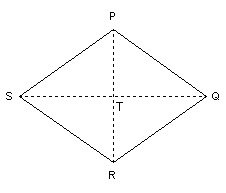
|
|
|
55.
|
Determine the sum of the lengths of the diagonals. 
|
|
|
56.
|
The perimeter of a right triangle is 40 m.
The length of the longest side of
the triangle is 17 m.
Find the lengths of the other two sides.
|
|
|
57.
|
Calculate the radius of the cylinder that can be made from each net. Show your
work. Use p = 3.14 and round your answer to 1 decimal place if
necessary. a)
b)
|
|
|
58.
|
A right rectangular prism has these faces:
2 faces of area 55
cm2
2 faces of area 66 cm2
2 faces of area 30 cm2
Find the
dimensions of the prism.
|
|
|
59.
|
A right rectangular prism has a volume of 28 cm3.
What are the
possible whole number dimensions of the prism in centimetres?
|
|
|
60.
|
An object is built using more than 1 linking cube.
The top view, front view,
and side views of the object are the same.
Sketch 2 objects that match the above
description.
|